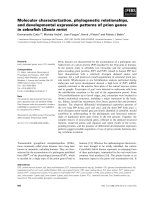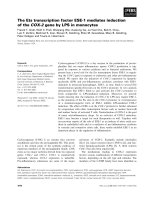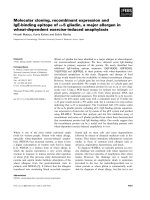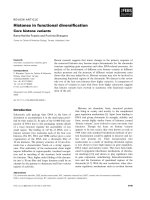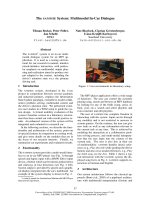Báo cáo khoa học: "Differences in vegetation cover resulting from various methods of site preparation for pine plantations in South Africa" potx
Bạn đang xem bản rút gọn của tài liệu. Xem và tải ngay bản đầy đủ của tài liệu tại đây (555.87 KB, 10 trang )
Original
article
Differences
in
vegetation
cover
resulting
from
various
methods
of
site
preparation
for
pine
plantations
in
South
Africa
JB
Zwolinski
DGM
Donald
1
School
of
Forestry,
Auburn
University,
Auburn,
AL
36849-5418,
USA;
2
Faculty
of
Forestry,
University
of
Stellenbosch, Stellenbosch,
South
Africa
(Received
25
November
1993;
accepted
5
October
1994)
Summary —
Species
composition,
height,
cover,
and
biomass
of
vegetation
were
examined
in
response
to
forest
regeneration
methods
applied
in
exotic
tree
plantations
of
Pinus
radiata
in
South
Africa.
The
experimental
treatments
involved
4
soil
cultivation
techniques
(pitting,
augering,
ripping
and
disk-
ing)
and
2
levels
of
weed
control
(standard
and
intensive).
Both
species
cover
and
composition
were
significantly
affected
by
the
experimental
treatments.
However,
the
most
important
weed
species
remained
common
irrespective
of
the
site
preparation
technique
applied.
More
research
is
needed
to
find
methods
for
selective
control
of
weed
species.
tree
plantations
/ biodiversity
/ competing
vegetation
/ weed
control
/ soil
cultivation
Résumé —
Effet
des
méthodes
de
préparation
de
site
sur
la
couverture
végétale
dans
les
plan-
tations
de
pin
en
Afrique
du
Sud. La
diversité
des
espèces,
la
hauteur,
la
couverture
et
la
biomasse
végétale
des
plantations
exotiques
de
Pinus
radiata
ont
été
examinées
en
fonction
des
méthodes
de
régénération
de
forêt
en
Afrique
du
Sud.
Les
traitements
expérimentaux
comprennent
4
méthodes
de
préparation
du
sol,
et 2
niveaux
de
contrôle
des
mauvaises
herbes
(standard
et
intensif).
Les
traitements
expérimentaux
ont
un
effet
sur
la
couverture
et
la
diversité
des
espèces.
Pourtant,
les
espèces
adven-
tices
les
plus
importantes
restent
présentes
quelle
que
soit
la
technique
utilisé
pour
préparer
le
site.
Des
recherches
supplémentaires
sont
requises
pour
trouver
des
méthodes
de
contrôle
sélectif
des
espèces
adventices.
plantations
forestières / diversité
biologique / compétition
végétale / contrôle
des
mauvaises
herbes
/ préparation
du
sol
INTRODUCTION
There
are
about
7
000
species
of
plants,
of
which
more
than
half
are
endemic,
in
the
Cape
Province
of
South
Africa.
Endemic
families
include:
Bruniaceae
(12
genera,
75
species),
Geisolomataceae
(1
species),
Grubbiaceae
(2
genera,
5
species),
Penae-
ceae
(5
genera,
25
species),
Retziaceae
(5
genera,
12
species).
The
other
character-
istic
families
are,
Ericaceae
(c 650
endemic
species),
Proteaceae
(c
320
endemic
species),
Restionaceae
(c
180
endemic
species),
Rutaceae-Diosmeae
(c
150
endemic
species)
(White,
1983).
The
preva-
lent
vegetation
in
the
Cape
region
is
fyn-
bos,
occurring
in
the
form
of
1-3
m
tall
scle-
rophyllous
shrubland.
Apart
from
some
extreme
habitats,
stands
of
fynbos
contain
a
mixture
of
species.
Taylor (1972)
recorded
121
species
of
flowering
plants
from
a
single
100
m2
homogenous
stand.
Grasses
are
uncommon
and
usually
occur
in
disturbed
areas,
but
were
much
more
abundant
before
European
settlement
(Ackocks,
1971).
It
is
now
believed
that
fynbos
evolved
in
the
presence
of
recurrent
fires.
In
the
absence
of
fire,
many
fynbos
species
become
mori-
bund
and
die.
Therefore,
some
species
became
almost
extinct
due
to
protection
against
fire,
and
today,
controlled
fires
are
applied
to
preserve
fynbos.
There
are
also
large
patches
of
indigenous
forests
pre-
served
in
this
region.
Plateau
forest
is
a
high,
evergreen
and
mixed
forest,
composed
of
dominant
tree
species
such
as
Olea
capensis
subsp
macrocarpa,
Podocarpus
latifolius
and
P
falcatus,
Platylophys
trifo-
liatus,
and
Apodytes
dimidiata.
Trichocladus
crinitus,
Rhumora
adiantiformis,
and
Blech-
num
punctulatum
are
the
major
understory
species.
In
the
moist
forest
type,
the
most
common
species
are
Cunonia
capensis
and
Platylophys
trifoliatus.
The
indigenous
forest
was
heavily
exploited
in
the
past,
especially
for
Ocotea
bullata
and
Podocarpus
spp
timber,
but
tim-
ber
production
from
indigenous
forests
was
not
sufficient
to
satisfy
the
demand.
Estab-
lishment
of
exotic
tree
plantations
during
the
last
century
resulted
in
suppression
of
natural
vegetation
("weeds")
on
extensive
areas.
Large
areas
of
fynbos
have
been
invaded
by
aliens
introduced
for
land
recla-
mation
or
timber
production,
but
most
dis-
turbance
occurred
at
afforestation
when
indigenous
vegetation
was
burnt
and
the
land
ploughed.
Not
only
did
it
take
longer
for
the
vegetation
to
re-establish
itself,
but
also
a
single
society
returned
on
the
ploughed
ground
compared
to at
least
6
societies
after
spot
hoeing
("pitting")
(Donald
and
Schönau,
1963).
Species
diversity
of
indigenous
vegetation
was
further
reduced
once
exotic
tree
species
formed
a
closed
canopy
(Cowling
et al,
1976;
Richardson
and
van
Wilgen,
1986).
Other
silvicultural
treatments,
such
as
controlled
burning
under
the
canopy
of
mature
trees,
altered
the
com-
position
and
spread
of
the
vegetation
(Vlok
and de
Ronde,
1989).
However,
after
harvesting,
re-establish-
ment
of
exotic
plantations
is
usually
impeded
by
rapid
regeneration
of
competing
vege-
tation.
Immediate
timber
production
goals
can
be achieved
by
vegetation
control
("weeding"),
but
continued
suppression
of
native
plant
species
can
have
a
harmful
ecological
impact
on
long-term
site
quality
and
productivity
(Rapp,
1983;
Versveld
and
van
Wilgen,
1986).
Usually,
large
amounts
of
water
and
nutrients
are
released
after
harvesting
timber.
These
resources
are
uti-
lized
efficiently
by
the
species
that
invade
first
in
a
succession.
Such
species
are usu-
ally
characterized
by
rapid
growth
rates
and
high
rates
of
nutrient
absorption,
thus min-
imizing
nutrient
losses
from
the
ecosystem
(Chapin,
1993).
These
species
are
short-
lived
and
are
eventually
replaced
by
woody
plants.
Very
few,
if
any,
dominant
species
are
able
to
utilize
all
the
resources
of
any
area
or
preserve
those
that
they
do
not
use
for
themselves
(Grubb,
1977).
Preservation
of
the
resources
by
the
vegetation
is
enhanced
by
succession
(Odum,
1969;
Vitousek
and
Reiners,
1975)
and
diversity
(Auclair,
1983).
Therefore,
it
seems
impor-
tant
to
minimize
the
impact
of
silvicultural
treatments
on
the
composition
and
cover
of
the
natural
vegetation
while
reducing
com-
petition
to
levels
that
allow
adequate
tim-
ber
production
at
the
same
time.
This
article
examines
changes
in
species
composition,
height,
area
cover
and
biomass
of
competing
vegetation
in
response
to
for-
est
regeneration
methods
applied
after
har-
vesting
the
first
rotation
of
trees.
The
objec-
tives
are
limited
to
the
major
species
and
potential
competitors.
It
is
suspected
that
more
intensive
silvicultural
treatments
reduce
diversity
and
abundancy
of
the
veg-
etation
cover
while
aggravating
the
potential
for
spread
of
noxious
weeds.
The
effect
of
reduced
competition
on
tree
survival
and
growth
is
provided
by Zwolinksi
et al (1994).
STUDY
AREA
AND
METHODS
The
study
was
located
on
the
Tsitsikamma
plateau
in
the
southern
Cape
Province
(34°
01’S,
24°
01’E,
200
masl).
In
the
1950s,
almost
2
000
ha
of
indigenous
vegetation
were
cleared
and
most
sites
were
planted
with
pines.
From
the
north,
this
plantation
is
surrounded
with
fynbos
preserved
on
extensive
areas
in
the
Outeniqua
and
Tsitsikamma
Mountains
while
its
southern
border
is
formed
by
indigenous
forest
growing
on
the
cliffs
of
the
Tsitsikamma
National
Park.
Soils
of
the
experimental
area
are
relatively
uni-
form,
moderately
deep
and
are
classified
with
the
South
African
Binomial
Classification
as a
Kroon-
stad-Oakleaf
intergrate
(MacVicar,
1990)
which
is
equivalent
to
ochric
Planosol
of
the
FAO
classi-
fication
(MacVicar
et al,
1977).
The
topsoils
are
very
fine
textured
loam
or
silt
loam.
There
is
an
abrupt
transition
to
a
gleyed
yellow
clay
at
a
depth
of
0.8
m.
The
soils
are
hydromorphic
and
perched
water
tables
occur
due
to
gently
undulating
topo-
graphy
and
the
presence
of
an
impervious
clay
subsoil.
In
the
experimental
block,
the
previous
crop
was
Pinus pinaster
established
in
1951.
In
1989,
P
radiata
was
planted
after
the
1
st
rota-
tion
had
been
harvested,
producing
at
felling
245
m3
/ha
of
good
quality
timber.
In
this
region,
P
radiata
is
preferred
for
timber
production
if
fertilizer
is
applied
on
phosphorus
deficient
sites.
It
is
antic-
ipated
that
timber
production
will
increase
by
40%
due
to
appropriate
species
choice,
intensive
sil-
viculture,
and
fertilization.
A
split-split-plot
design
was
used
in
a
facto-
rial
combination
to
compare
4
methods
of
soil
cul-
tivation
(whole
plots),
2
levels
of
weed
control
(subplots),
and
2
size
classes
of
planting
stock
(sub-subplots).
For
the
purpose
of
this
study,
the
seedling
grade
treatment
was
not
taken
into
con-
sideration
because
the
impact
of
the
seedling
grade
on
vegetation
regeneration
and
growth
is
minimal
within
the
1 st
year
after
planting.
Soil
cul-
tivation
treatments
included
pitting,
augering,
rip-
ping
(subsoiling),
and
ripping
and
disk-ploughing.
Pitting
is
the
standard
site
preparation
procedure
in
the
region
and
involves
digging
a
pit
(45
cm
wide
and
20
cm
deep)
with
a
hoe.
Augering
pro-
duced
a
planting
pit
(45
cm
wide
and
40
cm
deep)
with
a
2-man
mechanical
soil
auger
(Sthil
BT
308).
Both
treatments
were
applied
in
May
1989.
Rip-
ping
(to
60
cm
depth)
on
parallel
planting
lines
(spaced
at
2.7
m)
was
done
with
a
D7
bulldozer
equipped
with
a
1-tooth
subsoiler.
The
most
inten-
sive
treatment
involved
ripping
on
planting
lines,
disk-ploughing
(to
25
cm
depth
on
average)
and
disk-harrowing
of
the
whole
area.
Ripping
and
ploughing
were
preceded
by
manual
removal
of
slash
and
destumping
with
a
Bellaco
Destumper
mounted
on
a
tractor.
Ripping
and
ploughing
treat-
ments
were
applied
in
July
1989.
Weeds
were
controlled
either
with
the
standard
method
(slash-
ing
of
weeds
at
planting
and
1
year
later
to
prevent
overtopping
of
the
planted
trees)
or
with
inten-
sive
("total")
weed
control
which
involved
hoeing
and
pulling
of
the
vegetation
and
application
of
herbicides.
Chemical
weed
control
included
broad-
cast
applications
of
glyphosate
at
2
kg
ae/ha
3
and
1
months
before
planting,
and
a
broadcast
application
of
hexazinone
at
2
kg
ai/ha
7
months
after
planting.
In
each
of
the
64
experimental
units,
100
trees
were
planted
at
2.7
m
spacing
and
fer-
tilized
with
208
g/tree
of
superphosphate
(10.5%
P)
in
September
1989.
The
size
of
the
whole-plot
and
the
subplot
was
0.2916
and
0.1458
ha,
respectively.
In
total,
4
replications
of
this
exper-
iment
were
established
on
4.6656
ha
area.
A
pilot
survey
of
forest
floor
vegetation
was
conducted
before
and
after
harvesting
of
the
pre-
vious
crop,
by
laying
a
transect
in
the
compart-
ment
and
identifying
plants
that
occurred
along
it.
In
the
experimental
plots,
vegetation
was
sur-
veyed
before
(28
April
1989)
and
after
(1
Febru-
ary
1990)
treatment
application,
and
1
year
after
planting
(26
September
1990).
During
the
post-
harvesting
surveys,
5,
1
m2
circular
sampling
plots
were
established
at
random
in
every
subplot.
Total
vegetation
cover
was
estimated
as
per-
centage
area
covered
with
live
vegetation.
Height
of
the
vegetation
was
recorded
as
the
average
height
of
the
estimated
major
plant
biomass
com-
ponent
within
the
1
m2
plots.
The
major
species,
that
is,
the
species
which
contributed
at
least
25%
to
the
total
plant
biomass
of
each
sample,
were
identified.
Vegetation
was
harvested
on
a
0.25
m2
circular
area
of
each
sample
plot
and
bulked
within
a
subplot.
Dry
biomass
of
each
sample
was
recorded.
Species
composition
was
classified
using
the
2-way
indicator
species
analysis
Twinspan
(Hill,
1979).
In
a
phytosociological
context,
the
data
matrix
consisted
of
cross
classification
of
sub-
plots
between
the
major
species
and
soil
culti-
vation
combined
with
weed
control
treatments
(samples).
In
this
method,
a
classification
of
the
samples
is
used
to
obtain
a
classification
of
the
species
according
to
their
habitat
preference.
The
2
classifications
are
then
used
together
to
obtain
a
2-way
table
that
expresses
the
species’
syne-
cological
relations.
Within
each
survey,
2
groups
of
treatments
were
defined
by
2
distinctive
groups
of
species
(a
and
c).
The
3rd
group
of
vegeta-
tion
(group
b)
consisted
of
species
common
for
both
groups
of
treatments.
The
vegetation
cover,
height,
and
biomass
were
compared
with
analy-
sis
of
variance.
The
means
for
specific
treatment
levels
were
tested
with
Tukey
HSD
test.
Details
regarding
sampling
procedure
and
statistical
anal-
ysis
are
discussed
by
Zwolinksi
(1992).
RESULTS
AND
DISCUSSION
The
mature
stands
of
the
exotic
tree
species
suppressed
natural
vegetation.
However,
the
number
of
species
recorded
6
months
after
harvesting
increased
by
72%,
that
is,
from
46
under
the
stand
conopy
to
79
in
the
cleared
field
(table
I).
It
is
suggested
that
some
of
the
species
regenerated
from
seed
stored
in
the
soil
(eg,
Asteraceae)
or
rhi-
zomes
(eg,
Pteridium
aquilinum),
while
oth-
ers
invaded
exposed
soil
from
the
surround-
ing
openings
(eg,
Taraxacum
officinale).
Frequencies
of
occurrence
of
the
major
species
in
the
sample
plots
during
the
3
post-harvesting
surveys
is
shown
in
table
II.
In
general,
the
number
of
species
and
occurrence
frequency
increased
after
site
preparation.
One
year
after
planting,
how-
ever,
fewer
species
were
recorded,
but
fre-
quency
of
occurrences
generally
increased.
Within
the
1
st
year
after
treatment,
the
plant
species
reacted
in
various
ways
and
could
be
divided
into
the
following
principal
groups:
i)
species
which
occurred
more
frequently
after
treatment
application
(Rubus
pinna-
tus,
Pteridium
aquilinum,
Themeda
trian-
dra,
Senecio
sp,
Psoralea
ensifolia,
Helichry-
sum
petiolare);
ii)
species
which
were
initially
stimulated,
but
later
became
suppressed
(Taraxacum
officinale,
Centella
coriacea,
Helichrysum
cymosum,
Pentaschistis
angustifolia);
iii)
species
which
were
initially
suppressed
by
the
treatments,
but
later
recovered
(Hypoxis
villosa,
Tetraria
cuspidata,
Pinus
pinaster,
Oxalis sp,
Galopina
circeoides);
iv)
species
which
declined
after
treatment
application
(Andropogon
appendiculare,
Erharta
calycina,
Myrica
serrata,
Halleria
lucida,
Cymbopogon
marginatus).
A
decrease
in
the
number
of
species,
but
an
increase
in
occurrence
frequency
may
indicate
domination
of
the
communities
by
some
of
the
species
better
adapted
to
the
site
conditions
modified
by
the
site
prepa-
ration
methods.
Perennials
such
as
Rubus
pinnatus,
Pteridium
aquilinum,
Helichrysum
spp
and
grasses
became
dominant
species
because
they
can
accumulate
resources
and
suppress
other
species.
These
species
can
be
controlled
by
a
pre-harvesting
burn
(Vlok
and
de
Ronde,
1989).
Frequency
of
natural
regeneration
of
Pinus pinasterwas
initially
reduced
by
hand
pulling,
but
new
regeneration
resulted
from
abundant
seed
reserves
in
the
soil.
Clearly,
the
major
effort
to
control
competing
vegetation
should
con-
centrate
on
species
of
the
groups
(i)
and
Rubus pinnatus,
Senecio sp,
Pteridium
aquilinum,
Tetraria
cuspidata,
Helichrysum
petiolare,
Pinus
pinaster,
Themeda
trian-
dra,
and
Psaralea
ensifolia
are
believed
to
be
among
the
most
competitive
species
retarding
the
establishment
of
commercial
tree
species
in
this
region.
Grouping
of
the
plant
species
for
the
treatment
plots
(table
III)
showed
that
the
experimental
area
demarcated
for
ripping
and
augering
combined
with
total
weed
con-
trol
was
covered
with
specific
plant
species
(group
c)
which
were
only
sporadically
recorded
in
plots
allocated
to
the
other
treat-
The
differences
in
species
compo-
sition
were
reduced
by
treatment
applica-
tion.
Five
months
after
the
treatments
had
been
applied,
only
augering
combined
with
standard
weed
control
was
represented
by
a
specific
vegetation
group.
One
year
after
planting,
augering,
pitting
and
ripping,
each
combined
with
standard
weed
control,
were
covered
with
uniform
vegetation
(group
a).
A
2nd
group,
consisting
of
all
the
soil
culti-
vation
treatments
combined
with
total
weed
control,
had
significantly
reduced
cover.
Disking
combined
with
standard
weed
con-
trol
resulted
in
almost
total
control
of
vege-
tation,
and
weed
control
treatment
was
irrel-
evant.
Species
considered
as
the
strongest
competitors -
Rubus
pinnatus,
Senecio
sp,
Pteridium
aquilinum,
Tetraria
cuspidata,
Helichrysum
petiolare,
Psoralea
ensifolia,
Pinus
pinaster and
Themeda
triandra - were
recorded
frequently
throughout
the
survey
period,
forming
a
vegetation
group
(group
b)
not
related
to
any
specific
treatment.
Vegetation
height,
cover
and
dry
biomass
are
shown
in
table
IV
for
each
of
the
sur-
veys.
The
vegetation
cover
was
best
con-
trolled
in
disked
plots.
Disking
combined
with
total
weed
control
reduced
the
vege-
tation
to
2.9%
in
cover,
0.1 %
in
height,
and
1.1
%
in
biomass
compared
to
the
pre-treat-
ment
values.
Disking
results
in
existing
veg-
etation
and
humic
soil
horizons
being
cov-
ered
with
mineral
soil
from
deeper
horizons.
This
prevents
immediate
re-colonization
of
the
sites
by
the
vegetation.
Despite
a
rela-
tively
low
mean
vegetation
cover
and
height,
however,
individual
trees
could
be
subjected
to
severe
competition
where
Senecio
spp
is
regenerated
on
the
exposed
mineral
soil.
Senecio
spp
spread
quickly
on
bare
ground
and
grew
rapidly,
overtopped
the
trees
and
caused
occasional
mechanical
damage
through
wind
buffeting.
The
amount
of
vegetation
increased
after
augering
or
pitting
combined
with
standard
weed
control.
One
year
after
planting,
auger-
ing
and
standard
weed
control
produced
2 641
kg
ha-1
of
vegetation,
that
is,
47
times
more
than
the
combination
of
disking
and
total
weed
control.
The
standard
method
of
site
preparation
in
the
region
(ie,
pitting
and
standard
weed
control)
yielded
the
2nd
largest
amount
of
vegetation
not
differing
significantly
from
augering
and
standard
weed
control.
Frequently,
pits
were
invaded
by
grasses
taking
advantage
of
the
fertil-
izer
applied
on
the
soil
surface
around
the
planted
trees.
The
average
reduction
of
veg-
etation
biomass
by
90%
through
"total
weed
control"
was
achieved
by
repetitive
mechan-
ical
and
chemical
measures.
CONCLUSIONS
i)
Natural
vegetation
regenerates
rapidly
and
colonizes
bare
ground
when
released
from
tree
competition
after
timber
harvesting.
Its
natural
successional
development,
how-
ever,
is
disturbed
by
site
preparation
for
tree
planting
and
rapid
natural
regeneration
of
exotic
trees.
The
impact
of
this
repetitive
disturbance
on
regeneration
potential
of
the
native
species
and
their
continued
presence
on
the
sites
is
unknown.
ii)
The
cover
of
competing
vegetation
is
sig-
nificantly
reduced
by
intensive
soil
cultivation
and
weed
control.
However,
the
most
impor-
tant
weed
species
in
tree
plantations
remain
common
irrespective
of
the
site
preparation
method
applied.
iii)
It
is
recommended
that
the
time
between
harvesting
and
re-establishment
be
reduced
to
decrease
competition
from
natural
veg-
etation
and
to
reduce
costs
of
weed
con-
trol.
More
research
is
needed
to
find
bet-
ter
control
measures
against
the
important
weeds.
ACKNOWLEDGMENTS
This
study
was
funded
by
the
Department
of
Water
Affairs
and
Forestry
and
conducted
by
the
Division
of
Forest
Science
and
Technology
of
CSIR
in
South
Africa.
Messrs
J
Vlok
and
M
Viviers
are
thanked
for
their
help
in
the
identification
of
plant
species.
REFERENCES
Ackocks
JPH
(1971)
The
distribution
of
certain
ecolog-
ically
important
grasses
in
South
Africa.
Mitt
Bot
Staatssamml Munch
10,
149-160
Auclair
D
(1983)
"Natural"
mixed
forests
and
"artificial"
monospecific
forests.
In:
Disturbance
and
ecosys-
tems:
components
of
response
(HA
Mooney,
M
Gor-
don,
eds),
Springer-Verlag,
Berlin,
Heidelberg,
New
York,
Tokyo,
71-82
Chapin
FSIII
(1983)
Patterns
of
nutrient
absorption
and
use
by
plants
from
natural
and
man-modified
envi-
ronments.
In:
Disturbance
and
ecosystems:
com-
ponents
of
response
(HA
Mooney,
M
Gordon,
eds),
Springer-Verlag,
Berlin,
Heidelberg,
New
York,
Tokyo,
175-187
Cowling
RM,
Moll
EJ,
Campbell
BM
(1976)
The
eco-
logical
status
of
the
understorey
communities
of
pine
forests
on
Table
Mountain.
S Afr For J 99,
13-
23
Donald
DGM,
Schönau
APG
(1963)
Some
preliminary
results
from
a
fertilizer/cultivation
experiment
with
Pinus
radiata.
For S Afr2,
53-69
Grubb
PJ
(1977)
The
maintenance
of
species-richness
in
plant
communities:
the
importance
of
the
regen-
eration
niche.
Biol
Rev 52,
107-145
Hill
MO
(1979)
Twinspan:
a
Fortran
programme
for
arranging
multivariate
data
in
an
ordered
2-way
table
by
classification
of
the
individuals
and
the
attributes.
Cornell
Univ,
New
York,
90
p
MacVicar
CN
(1990)
Soil
classification
for
South
Africa.
Memoirs
on
the
Agricultural
Natural
Resources
of
South
Africa
15.
Dept
of
Agricultural
Development,
Pretoria,
257
p
MacVicar
CN
et
al
(1977)
Soil
classification:
a
binomial
system
for
South
Africa.
Dept
of
Agricultural
Tech-
nical
Services,
Pretoria,
150
p
Odum
EP
(1969)
The
strategy
of
ecosystem
develop-
ment.
Science
164,
262-270
Rapp
M
(1983)
Some
problems
of
disturbance
on
the
nutrient
cycling
in
ecosystems.
In:
Disturbance
and
ecosystems:
components
of
response
(HA
Mooney,
M
Gordon,
eds),
Springer-Verlag,
Berlin,
Heidelberg,
New
York,
Tokyo,
117-128
Richardson
DM,
van
Wilgen
BW
(1986)
Effects
of
35
years
of
afforestation
with
Pinus
radiata
on
the
com-
position
of
mesic
mountain
fynbos
near
Stellenbosch.
S
Afr
J
Bot
52, 309-315
Taylor
HC
(1972)
Notes
on
the
vegetation
of
the
Cape
Flats.
Bothalia
10,
637-646
Versveld
DB,
van
Wilgen
BW
(1986)
Impact
of
woody
aliens
on
ecosystem
properties.
In:
The
ecology
and
management
of biological
invasions
in
South-
em
Africa
(IAW
Macdonald,
FJ
Kruger,
AA
Ferrar,
eds),
Oxford
University
Press,
Cape
Town,
239-
246
Vitousek
PM,
Reiners
WA
(1975)
Ecosystem
succes-
sion
and
nutrient
retention:
a
hypothesis.
BioScience
22, 376-381
Vlok
JHJ,
de
Ronde
C
(1989)
The
effect
of
low-inten-
sity
fires
on
forest
floor
vegetation
in
mature
Pinus
elliottii
plantations
in
the
Tsitsikamma.
S
Afr
J
Bot
55, 11-16
White
F
(1983)
The
vegetation
of
Africa.
A
descriptive
memoir
to
accompany
the
Unesco/AETFAT/UNSO
vegetation
map
of
Africa.
Unesco,
356
p
Zwolinski
JB
(1992)
Regeneration
procedures
and
mortality
of
Pinus
radiata
D.
Don
in
the
southern
Cape
Province.
PhD
Thesis,
University
of
Stellenbosch,
xxiv
+
257
p
Zwolinski
JB,
Donald
DGM,
van
Laar
A,
Groenewald
WH
(1994)
Regeneration
procedures
of
Pinus
radi-
ata
in
the
southern
Cape
Province.
V.
Post
planting
mortality
and
growth
of
trees
in
response
to
the
experimental
treatments
and
planting
site
environ-
ment.
S Afr For J 168,
7-12


